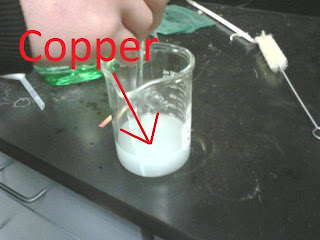The first double replacement precipitation reaction in the lab was Cu(NO3)2(aq) + 2NaOH(aq) --> CuOH2(s) + 2NaNO3(aq). The driving force behing this reaction is formation of a solid (Copper(II) Hydroxide). These particular products were formed because copper traded places with sodium (Double Replacement).
The second double replacement precipitation reaction in the lab was 3CuCl2(aq) + 2Na3PO4(aq) --> Cu3(PO4)2(s) + 6NaCl(aq). The driving force in this reaction was formation of a solid (Cupric Phosphate). The particular products formed because copper and sodium traded places making cupric phosphate and sodium chloride.
Copper Blog
Friday, December 10, 2010
Single Replacement Reaction
The single replacement reaction in this lab is CuSO4(aq) + Zn(s) --> ZnSO4(aq) + Cu(s). The driving force for this reaction is formation of a solid (Cu), and this happens because zinc has the higher electronegativity and therefore pulls the sulfate ions away from the copper, leaving the copper all by itself plus Zinc Sulfate floating around in the solution.
CuSO4(aq) + Zn(s) --> ZnSO4(aq) + Cu(s)
Cu3(PO4)2(s) + 3H2SO4(aq) --> 3CuSO4(aq) + 2H3PO4(aq)
3CuCl2(aq) + 2Na3PO4(aq) --> Cu3(PO4)2(s) + 6NaCl(aq)
Wednesday, December 8, 2010
CuO(s) + 2HCl(aq) --> CuCl2(aq) + H2O(l)
Monday, December 6, 2010
Subscribe to:
Posts (Atom)





